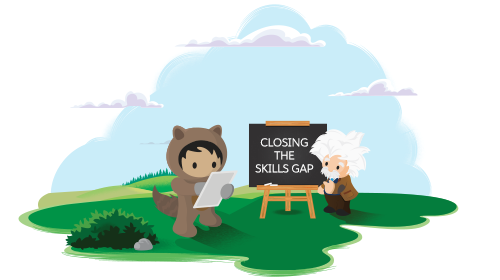Creating an action plan for your business in the current climate is challenging. The global pandemic has completely shifted the business landscape and catalysed new market demands. Even the way we engage with customers has changed. But that doesn't mean we can't create a action plan to put our businesses back into motion and connect with customers in new ways.
In our COVID-19 Response Playbook, we provide business leaders with a 3-track structured approach to help guide them during a time of massive economic uncertainty. Our goal is to help businesses lead and build resilience for the Next Normal. And it's vital to create an action plan that works to close the gap between your current workforce and the skills needed for the future of work.
As we move into the Next Normal, there is increasing talk about a growing “skills gap.” Years ago, when impactful technologies like these came along, you could upskill your workforce over a few years. Now, technologies emerge so quickly that it’s becoming difficult to educate people quickly enough.
According to the World Economic Forum, 35% of the skills required for jobs across industries will change by 2020. This is especially true in the IT sector.
Effective action planning enables a business to determine and address the skills needed for the future. It ensures that you align workforce requirements with the company’s strategic objectives and goals. Failing to devise a comprehensive plan puts businesses at risk of missing out on opportunities to develop key talent and prepare their team to take on new tasks. This can threaten their competitive edge.
Below, we list 5 steps to help you create an action plan and ensure the growth and success of your business:
1. Set a strategic direction
Addressing a current skills gap requires a deep understanding of where your company is going. Review your company’s strategic plan with leaders and identify the skills necessary to meet goals and objectives both now and in the future.
You could also peruse job listings to see what skills and abilities are valuable to your competitors or benchmark your current team against industry-standard models, such as those published by industry organisations. This will help you gain a better understanding of what skills you may need in the future.
2. Analyse skills
Analyse your current employees’ skills with a skills gap analysis for each job role. This will help you evaluate the gaps in the skills you desire and those your employees have. For instance, you may find that your current employees lack the technical skills that will be important as you shift to an AI-enabled workplace.
Once you know what skills are missing, you can consider training and education options that will help your employees reach your desired skill levels.
3. Develop an action plan
Once you have determined the skills you require and identified the current skills gaps with your employees, you can develop a plan to close those gaps. You may design, develop, or deliver courses to address specific skills in different areas of your company, such as technical or strategic thinking. You can use a template or create your own table or graph to record your results and document your plan.
To prepare for your future needs, you can develop a recruiting system to screen for promising candidates that possess your desired skills. If you have a skills gap in only one area or related to one project, you may want to consider contractors or other outside resources to lead your team and provide on-the-job coaching.
However you intend to address the skills gap, it’s vital that you strategise and implement ways to measure your success. This will help you stay on track and ensure that your efforts are successful.
4. Implement a plan
Before implementing your business plan, be sure that your goals are realistic and you have the financial and human resources to reach them. For your plan to be successful, all of your leaders and employees need to have a solid understanding of their responsibilities and roles, as well as the performance metrics.
It’s important to routinely evaluate your metrics and make improvements to any areas that aren’t delivering. You may also want to consider implementing solutions to help your employees succeed, such as software or platforms that allow any employee to create tools or apps, not just IT employees.
5. Close the gap
Closing the skills gaps is a growing concern in the new business landscape. With a skills gap analysis and action plan, you can ensure that all of your employees have the training and skills needed to tackle challenges and become more productive. Conducting a skills gap analysis starts with identifying the skills that are valuable to your business and what skills are needed for future workforces. You can gain insights from conducting a survey of team members and consulting human resources (HR) managers.
The next step is determining the skills your current employees possess. This can be done with assessments, surveys, and/or employee interviews. Once you have your list of valuable skills, you can use a table or graph to identify while skills are missing from your workforce. To close the gap, offer training, coaching, certifications, professional events, and mentorship to nurture current employees. You can also hire new employees with the skills that your business is missing.
If you're interested in skilling up your workforce to meet new business demands, check out how to create a culture of online learning with myTrailhead.
As businesses around the world gradually reopen, we understand that returning to work safely is a main priority for employers. To help business owners during this time, we've created work.com to prepare them with essential solutions for returning to the workplace as quickly and safely as possible.




